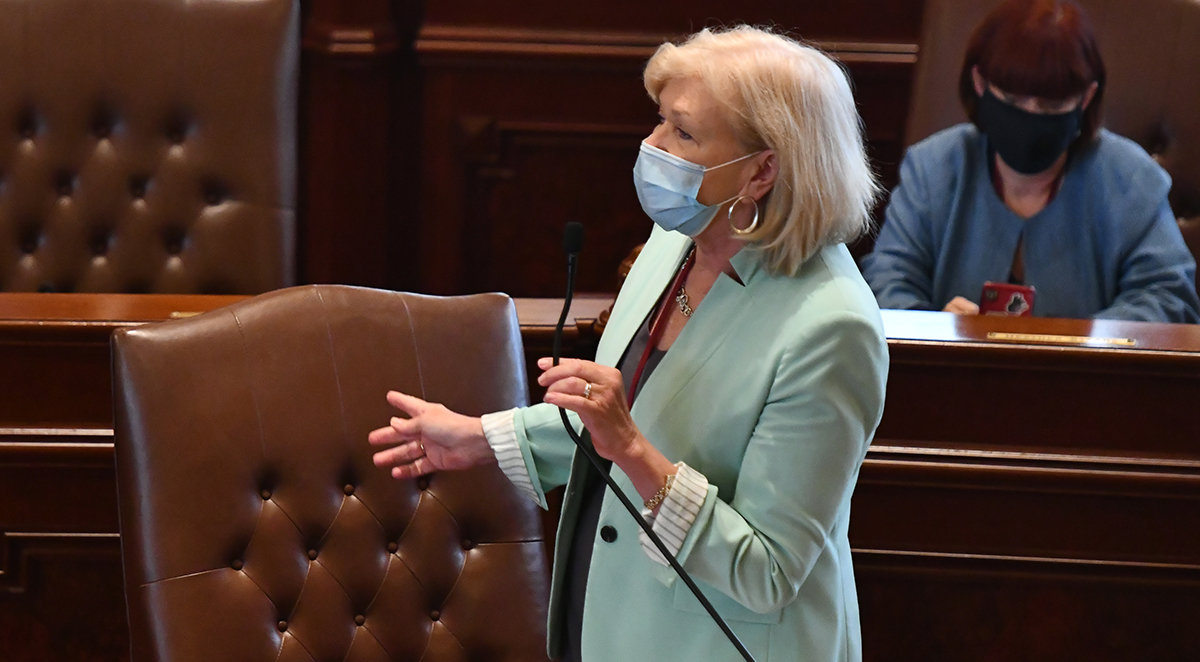Morrison supports censure of Rep. Miller over Hitler remarks
- Details
- Category: Latest News
SPRINGFIELD – Following disgraceful remarks by Illinois Congresswoman Mary Miller (R-Oakland) quoting Adolf Hitler, State Senator Julie Morrison (D-Lake Forest) joined her colleagues in the Illinois Jewish Legislative Caucus to call on Congress to censure her.
“Any person who displays anti-Semitism should not be able to have the honor to serve as an elected official,” Morrison said. “Regardless of your religious beliefs, you should be disgusted and offended by the words said by this newly-elected congresswoman.”
Senate Resolution 1609 calls on Congress to censure Miller after she quoted Hitler during a speech. Many people on both sides of the aisle have urged Miller to resign.
“I stand with my colleagues in the Illinois Jewish Legislative Caucus and the many people in my district who are of the Jewish faith in fighting against hateful expressions of intolerance,” Morrison said. “We will not stand for this hate speech.”
A copy of the resolution will be sent to the president and vice president of the United States on Jan. 21.
Morrison’s secure drop box bill heads to House
- Details
- Category: Vote-by-mail
SPRINGFIELD – A safer way to turn in vote-by-mail ballots may soon be on its way to counties across the state after State Senator Julie Morrison (D-Lake Forest) successfully championed a measure to implement more secure drop boxes.

“We should make it simpler to vote – even in a non-COVID world,” Morrison said. “Everyone should have a safe and secure way to cast their ballot.”
House Bill 3994 would allow election authorities to establish permanent ballot drop boxes to accept vote-by-mail ballots. Election authorities would be able to receive reimbursement through the federal Help America Vote Act to pay for the boxes.
One of every three votes cast during the November 2020 General Election was cast via a mail ballot – but many of those were hand-delivered to drop boxes.
Morrison introduced the legislation after she heard concerns from some voters who weren’t comfortable with mailing their ballots. They wondered if the ballots would be delivered on time, if they would be lost in the mail and if they needed stamps – among other concerns. With this measure, many voters will have an additional way to safely cast their ballots.
“This is one more step to ensure people can safely exercise their right to vote,” Morrison said. “I will continue to fight to make it easier for voters’ voices to be heard — especially at a time when so many are relying on their elected officials for help.”
Morrison is also working with her colleagues to pass a comprehensive election plan this spring, which would include permanent expansion of last year’s vote-by-mail law.
The measure passed the Senate Tuesday and now heads to the House for final approval. If passed and later signed by the governor, it will be implemented by the spring municipal election.
Morrison fights for safer way to vote by mail
- Details
- Category: Vote-by-mail
SPRINGFIELD – State Senator Julie Morrison (D-Lake Forest) – who championed the state’s comprehensive vote-by-mail law last spring – is fighting for additional safe ways for voters to cast their ballots.
“A record number of Illinoisans voted by mail in November. As the COVID-19 pandemic continues, we must continue to give people an option to safely cast their ballots during local government primary elections this spring,” Morrison said. “One way we can provide another safe option is through secure drop boxes. It will give people peace of mind to know their ballots have arrived on time and are secure.”

One of every three votes cast during the November 2020 General Election was cast via a mail ballot – but many of those were hand-delivered to drop boxes. Morrison heard concerns from some voters who weren’t comfortable with mailing their ballot. They wondered if it would be delivered on time, if it would be lost in the mail and if it needed stamps – among other concerns.
Those issues led Morrison to sponsor House Bill 3994, which would allow election authorities to establish permanent ballot drop boxes to accept vote-by-mail ballots. Election authorities would be able to receive reimbursement through the federal Help America Vote Act to pay for the boxes.
“All people should be able to safely and securely exercise their right to vote,” Morrison said. “Creating permanent drop boxes would create convenient options for both voters and election authorities.”
The measure was presented to the Senate Executive Committee Sunday. It was introduced this week for intended action during the last days of the 101st General Assembly, so it can be implemented by the spring municipal election.
Morrison is also working with her colleagues to pass a comprehensive election bill this spring, which would include permanent expansion of last year’s vote-by-mail law.
Morrison fights for safer way to vote by mail
- Details
- Category: Vote-by-mail
SPRINGFIELD – State Senator Julie Morrison (D-Lake Forest) – who championed the state’s comprehensive vote-by-mail law last spring – is fighting for additional safe ways for voters to cast their ballots.
“A record number of Illinoisans voted by mail in November. As the COVID-19 pandemic continues, we must continue to give people an option to safely cast their ballots during local government primary elections this spring,” Morrison said. “One way we can provide another safe option is through secure drop boxes. It will give people peace of mind to know their ballots have arrived on time and are secure.”

One of every three votes cast during the November 2020 General Election was cast via a mail ballot – but many of those were hand-delivered to drop boxes. Morrison heard concerns from some voters who weren’t comfortable with mailing their ballot. They wondered if it would be delivered on time, if it would be lost in the mail and if it needed stamps – among other concerns.
Those issues led Morrison to sponsor House Bill 3994, which would allow election authorities to establish permanent ballot drop boxes to accept vote-by-mail ballots. Election authorities would be able to receive reimbursement through the federal Help America Vote Act to pay for the boxes.
“All people should have be able to safely and securely exercise their right to vote,” Morrison said. “Creating permanent drop boxes would create convenient options for both voters and election authorities.”
The measure was presented to the Senate Executive Committee Sunday. It was introduced this week for intended action during the last days of the 101st General Assembly, so it can be implemented by the spring municipal election.
Morrison is also working with her colleagues to pass a comprehensive election bill this spring, which would include permanent expansion of last year’s vote-by-mail law.
More Articles …
Page 73 of 133






